Land Surface Phenologies and Seasonalities in the US Prairie Pothole Region Coupling AMSR Passive Microwave Data with the USDA Cropland Data Layer
Abstract
:1. Introduction
2. Study Region, Data, and Methodology
2.1. Study Region
2.2. Data
2.3. Methods
3. Results
3.1. Mean CDL Land Cover Percentages at AMSR Scale
3.2. CDL Land Cover Time Series at the AMSR Pixel Scale
3.3. Interannual Dynamics of Land Surface Phenology and Seasonality
3.4. Spatial Dynamics of Land Surface Phenology
3.5. Convex Quadratic Models for GDD and V
3.6. Spatial and Temporal Variation in Land Surface Phenology and Seasonality Metrics
4. Discussion
5. Conclusions
Supplementary Materials
Author Contributions
Funding
Acknowledgments
Conflicts of Interest
References
- Johnston, C.A. Wetland Losses Due to Row Crop Expansion in the Dakota Prairie Pothole Region. Wetlands 2013, 33, 175–182. [Google Scholar] [CrossRef]
- Wright, C.K.; Larson, B.; Lark, T.J.; Gibbs, H.K. Recent grassland losses are concentrated around U.S. ethanol refineries. Environ. Res. Lett. 2017, 12, 044001. [Google Scholar] [CrossRef]
- Wright, C.K.; Wimberly, M.C. Recent land use change in the Western Corn Belt threatens grasslands and wetlands. Proc. Natl. Acad. Sci. USA 2013, 110, 4134–4139. [Google Scholar] [CrossRef] [Green Version]
- Lark, J.T.; Salmon, J.M.; Gibbs, K.H. Cropland expansion outpaces agricultural and biofuel policies in the United States. Environ. Res. Lett. 2015, 10, 044003. [Google Scholar] [CrossRef]
- Faber, S.; Rundquist, S.; Male, T. Plowed Under: How Crop Subsidies Contribute to Massive Habitat Losses; Environmental Working Group: Washington, DC, USA, 2012. [Google Scholar]
- Johnston, C.A. Cropland expansion into Prairie Pothole wetlands, 2001-2010. In Proceedings of the America’s Grasslands Conference: Status, Threats, and Opportunities, Sioux Falls, SD, Washington, DC, Brookings, SD, USA, 15–17 August 2011; pp. 44–46. [Google Scholar]
- Wachenheim, C.; Roberts, D.C.; Dhingra, N.; Lesch, W.; Devney, J. Conservation Reserve Program enrollment decisions in the Prairie Pothole Region. J. Soil Water Conserv. 2018, 73, 337–352. [Google Scholar] [CrossRef]
- Philip, E.M.; Stephen, D.L.; Christopher, M.C.; Richard, I. Grasslands, wetlands, and agriculture: The fate of land expiring from the Conservation Reserve Program in the Midwestern United States. Environ. Res. Lett. 2016, 11, 094005. [Google Scholar] [CrossRef]
- Wimberly, M.C.; Narem, D.M.; Bauman, P.J.; Carlson, B.T.; Ahlering, M.A. Grassland connectivity in fragmented agricultural landscapes of the north-central United States. Biol. Conserv. 2018, 217, 121–130. [Google Scholar] [CrossRef]
- Shaffer, J.A.; Roth, C.L.; Mushet, D.M. Modeling effects of crop production, energy development and conservation-grassland loss on avian habitat. PLoS ONE 2019, 14, e0198382. [Google Scholar] [CrossRef]
- Boryan, C.; Yang, Z.; Mueller, R.; Craig, M. Monitoring US agriculture: The US Department of Agriculture, National Agricultural Statistics Service, Cropland Data Layer Program. Geocarto Int. 2011, 26, 341–358. [Google Scholar] [CrossRef]
- Lark, T.J.; Mueller, R.M.; Johnson, D.M.; Gibbs, H.K. Measuring land-use and land-cover change using the U.S. Department of Agriculture’s Cropland Data Layer: Cautions and recommendations. Int. J. Appl. Earth Obs. Geoinf. 2017, 62, 224–235. [Google Scholar] [CrossRef]
- Reitsma, K.D.; Clay, D.E.; Clay, S.A.; Dunn, B.H.; Reese, C. Does the U.S. Cropland Data Layer Provide an Accurate Benchmark for Land-Use Change Estimates? Agron. J. 2016, 108, 266–272. [Google Scholar] [CrossRef]
- Nguyen, L.H.; Joshi, D.R.; Clay, D.E.; Henebry, G.M. Characterizing land cover/land use from multiple years of Landsat and MODIS time series: A novel approach using land surface phenology modeling and random forest classifier. Remote Sens. Environ. 2018. Available online: https://doi.org/10.1016/j.rse.2018.12.016 (accessed on 30 January 2019).
- Jones, M.O.; Kimball, J.S.; Jones, L.A.; McDonald, K.C. Satellite passive microwave detection of North America start of season. Remote Sens. Environ. 2012, 123, 324–333. [Google Scholar] [CrossRef]
- Liu, Y.Y.; van Dijk, A.I.J.M.; McCabe, M.F.; Evans, J.P.; de Jeu, R.A.M. Global vegetation biomass change (1988-2008) and attribution to environmental and human drivers. Glob. Ecol. Biogeogr. 2013, 22, 692–705. [Google Scholar] [CrossRef]
- Alemu, W.G.; Henebry, G.M. Land surface phenologies and seasonalities using cool earthlight in mid-latitude croplands. Environ. Res. Lett. 2013, 8, 045002, (10pp). [Google Scholar] [CrossRef]
- Alemu, W.G.; Henebry, G.M. Comparing Passive Microwave with Visible-To-Near-Infrared Phenometrics in Croplands of Northern Eurasia. Remote Sens. 2017, 9, 613. [Google Scholar] [CrossRef]
- Meesters, A.G.C.A.; de Jeu, R.A.M.; Owe, M. Analytical derivation of the vegetation optical depth from the microwave polarization difference index. IEEE Geosci. Remote Sens. Lett. 2005, 2, 121–123. [Google Scholar] [CrossRef]
- Wang, S.; Zhong, R.; Li, Q.; Qin, M. Drought Monitoring in Yunnan Province with AMSR-E-Based Data. In Proceedings of the Proc. SPIE 8203, Remote Sensing of the Environment: The 17th China Conference on Remote Sensing, Hangzhou, China, 15 August 2011; p. 820312. [Google Scholar]
- Kim, Y.; Kimball, J.S.; McDonald, K.C.; Glassy, J. Developing a Global Data Record of Daily Landscape Freeze/Thaw Status Using Satellite Passive Microwave Remote Sensing. IEEE Trans. Geosci. Remote Sens. 2011, 49, 949–960. [Google Scholar] [CrossRef]
- Frolking, S.; Milliman, T.; McDonald, K.; Kimball, J.; Zhao, M.; Fahnestock, M. Evaluation of the SeaWinds scatterometer for regional monitoring of vegetation phenology. J. Geophys. Res. Atmos. 2006, 111, D17302. [Google Scholar] [CrossRef]
- Jones, M.O.; Jones, L.A.; Kimball, J.S.; McDonald, K.C. Satellite passive microwave remote sensing for monitoring global land surface phenology. Remote Sens. Environ. 2011, 115, 1102–1114. [Google Scholar] [CrossRef]
- Min, Q.; Lin, B. Determination of spring onset and growing season leaf development using satellite measurements. Remote Sens. Environ. 2006, 104, 96–102. [Google Scholar] [CrossRef]
- Shi, J.; Jackson, T.; Tao, J.; Du, J.; Bindlish, R.; Lu, L.; Chen, K.S. Microwave vegetation indices for short vegetation covers from satellite passive microwave sensor AMSR-E. Remote Sens. Environ. 2008, 112, 4285–4300. [Google Scholar] [CrossRef]
- Van Marle, M.J.E.; Van Der Werf, G.R.; de Jeu, R.A.M.; Liu, Y.Y. Annual South American forest loss estimates based on passive microwave remote sensing (1990–2010). Biogeosciences 2016, 13, 609. [Google Scholar] [CrossRef]
- Frolking, S.; Fahnestock, M.; Milliman, T.; McDonald, K.; Kimball, J. Interannual variability in North American grassland biomass/productivity detected by SeaWinds scatterometer backscatter. Geophys. Res. Lett. 2005, 32, L2140. [Google Scholar] [CrossRef]
- Frolking, S.; Milliman, T.; Palace, M.; Wisser, D.; Lammers, R.; Fahnestock, M. Tropical forest backscatter anomaly evident in SeaWinds scatterometer morning overpass data during 2005 drought in Amazonia. Remote Sens. Environ. 2011, 115, 897–907. [Google Scholar] [CrossRef]
- Brandt, M.; Wigneron, J.-P.; Chave, J.; Tagesson, T.; Penuelas, J.; Ciais, P.; Rasmussen, K.; Tian, F.; Mbow, C.; Al-Yaari, A. Satellite passive microwaves reveal recent climate-induced carbon losses in African drylands. Nat. Ecol. Evol. 2018, 2, 827. [Google Scholar] [CrossRef] [PubMed]
- Kimball, J.S.; McDonald, K.C.; Running, S.W.; Frolking, S.E. Satellite radar remote sensing of seasonal growing seasons for boreal and subalpine evergreen forests. Remote Sens. Environ. 2004, 90, 243–258. [Google Scholar] [CrossRef]
- Kimball, J.S.; McDonald, K.C.; Zhao, M. Spring thaw and its effect on terrestrial vegetation productivity in the western Arctic observed from satellite microwave and optical remote sensing. Earth Interact. 2006, 10, 1–22. [Google Scholar] [CrossRef]
- Liu, Y.Y.; van Dijk, A.I.J.M.; McCabe, M.F.; Evans, J.P.; de Jeu, R.A.M. Global long-term passive microwave satellite-based retrievals of vegetation optical depth. Geophys. Res. Lett. 2011, 38, L18402. [Google Scholar] [CrossRef]
- Li, L.; Njoku, E.G.; Im, E.; Chang, P.S.; Germain, K.S. A preliminary survey of radio-frequency interference over the US in Aqua AMSR-E data. IEEE Trans. Geosci. Remote Sens. 2004, 42, 380–390. [Google Scholar] [CrossRef]
- Njoku, E.G.; Ashcroft, P.; Chan, T.K.; Li, L. Global survey and statistics of radio-frequency interference in AMSR-E land observations. IEEE Trans. Geosci. Remote Sens. 2005, 43, 938–947. [Google Scholar] [CrossRef]
- NASA_JPL. NASA Shuttle Radar Topography Mission Global 1 Arc Second. NASA EOSDIS Land Processes DAAC: 2013. Available online: https://doi.org/10.5067/MEaSUREs/SRTM/SRTMGL1.003 (accessed on 10 February 2019).
- Henebry, G.M.; de Beurs, K.M.; Wright, C.K.; Ranjeet, J.; Lioubimtseva, E. Dryland East Asia in Hemispheric Context. In Dryland East Asia: Land Dynamics Amid Social and Climate Change; Chen, J., Wan, S., Henebry, G., Qi, J., Gutman, G., Sun, G., Kappas, M., Eds.; Higher Education Press and Walter de Gruyter GmbH: Berlin, Germany; Boston, MA, USA, 2013; pp. 23–43. [Google Scholar] [CrossRef]
- Alemu, W.G.; Henebry, G.M. Characterizing Cropland Phenology in Major Grain Production Areas of Russia, Ukraine, and Kazakhstan by the Synergistic Use of Passive Microwave and Visible to Near Infrared Data. Remote Sens. 2016, 8, 1016. [Google Scholar] [CrossRef]
- Alemu, W.G.; Henebry, G.M. Land Surface Phenology and Seasonality Using Cool Earthlight in Croplands of Eastern Africa and the Linkages to Crop Production. Remote Sens. 2017, 9, 914. [Google Scholar] [CrossRef]
- Han, W.; Yang, Z.; Di, L.; Mueller, R. CropScape: A Web service based application for exploring and disseminating US conterminous geospatial cropland data products for decision support. Comput. Electron. Agric. 2012, 84, 111–123. [Google Scholar] [CrossRef]
- USDA National Agricultural Statistics Service Cropland Data Layer; Published crop-specific data layer [Online]; USDA-NASS: Washington, DC; Available online: https://nassgeodata.gmu.edu/CropScape/ (accessed on 20 July 2019).
- Du, J.; Kimball, J.S.; Jones, L.A.; Kim, Y.; Glassy, J.; Watts, J.D. A global satellite environmental data record derived from AMSR-E and AMSR2 microwave Earth observations. Earth Syst. Sci. Data 2017, 9, 791–808. [Google Scholar] [CrossRef] [Green Version]
- Du, J.; Kimball, J.S.; Shi, J.; Jones, L.A.; Wu, S.; Sun, R.; Yang, H. Inter-Calibration of Satellite Passive Microwave Land Observations from AMSR-E and AMSR2 Using Overlapping FY3B-MWRI Sensor Measurements. Remote Sens. 2014, 6, 8594–8616. [Google Scholar] [CrossRef] [Green Version]
- Park, H.M. Comparing Group Means: T-tests and One-Way ANOVA Using Stata, SAS, R, and SPSS; Indiana University: Bloomington, IN, USA, 2009. [Google Scholar]
- McCrum-Gardner, E. Which is the correct statistical test to use? Br. J. Oral Maxillofac. Surg. 2008, 46, 38–41. [Google Scholar] [CrossRef] [PubMed]
- Sahajpal, R.; Zhang, X.; Izaurralde, R.C.; Gelfand, I.; Hurtt, G.C. Identifying representative crop rotation patterns and grassland loss in the US Western Corn Belt. Comput. Electron. Agric. 2014, 108, 173–182. [Google Scholar] [CrossRef] [Green Version]
- Janssen, L.; Rickerl, D.; Stebbins, E.; Machacek, T. Economic and environmental contributions of wetlands in agricultural landscapes. In Proceedings of the 75th Annual Conference of the Soil and Water Conservation Society, Des Moines, IA, USA, 6–9 August 1995. [Google Scholar]
- Arora, G.; Wolter, P.T. Tracking land cover change along the western edge of the US Corn Belt from 1984 through 2016 using satellite sensor data: Observed trends and contributing factors. J. Land Use Sci. 2018, 13, 59–80. [Google Scholar] [CrossRef]
- USDA_FSA. Conservation Reserve Program Statistics; United States Department of Agriculture Farm Service Agency: Washington, DC, USA, 2019.
- Lark, T.J.; Larson, B.; Schelly, I.; Batish, S.; Gibbs, H.K. Accelerated Conversion of Native Prairie to Cropland in Minnesota. Environ. Conserv. 2019, 46, 155–162. [Google Scholar] [CrossRef]
- Lin, M.; Huang, Q. Exploring the relationship between agricultural intensification and changes in cropland areas in the US. Agric. Ecosyst. Environ. 2019, 274, 33–40. [Google Scholar] [CrossRef]
- Olimb, S.K.; Robinson, B. Grass to grain: Probabilistic modeling of agricultural conversion in the North American Great Plains. Ecol. Indic. 2019, 102, 237–245. [Google Scholar] [CrossRef]
- Nguyen, L.H.; Joshi, D.R.; Henebry, G.M. Improved Change Detection with Trajectory-Based Approach: Application to Quantify Cropland Expansion in South Dakota. Land 2019, 8, 57. [Google Scholar] [CrossRef]
- Johnston, C.A. Agricultural expansion: Land use shell game in the US Northern Plains. Landsc. Ecol. 2014, 29, 81–95. [Google Scholar] [CrossRef]
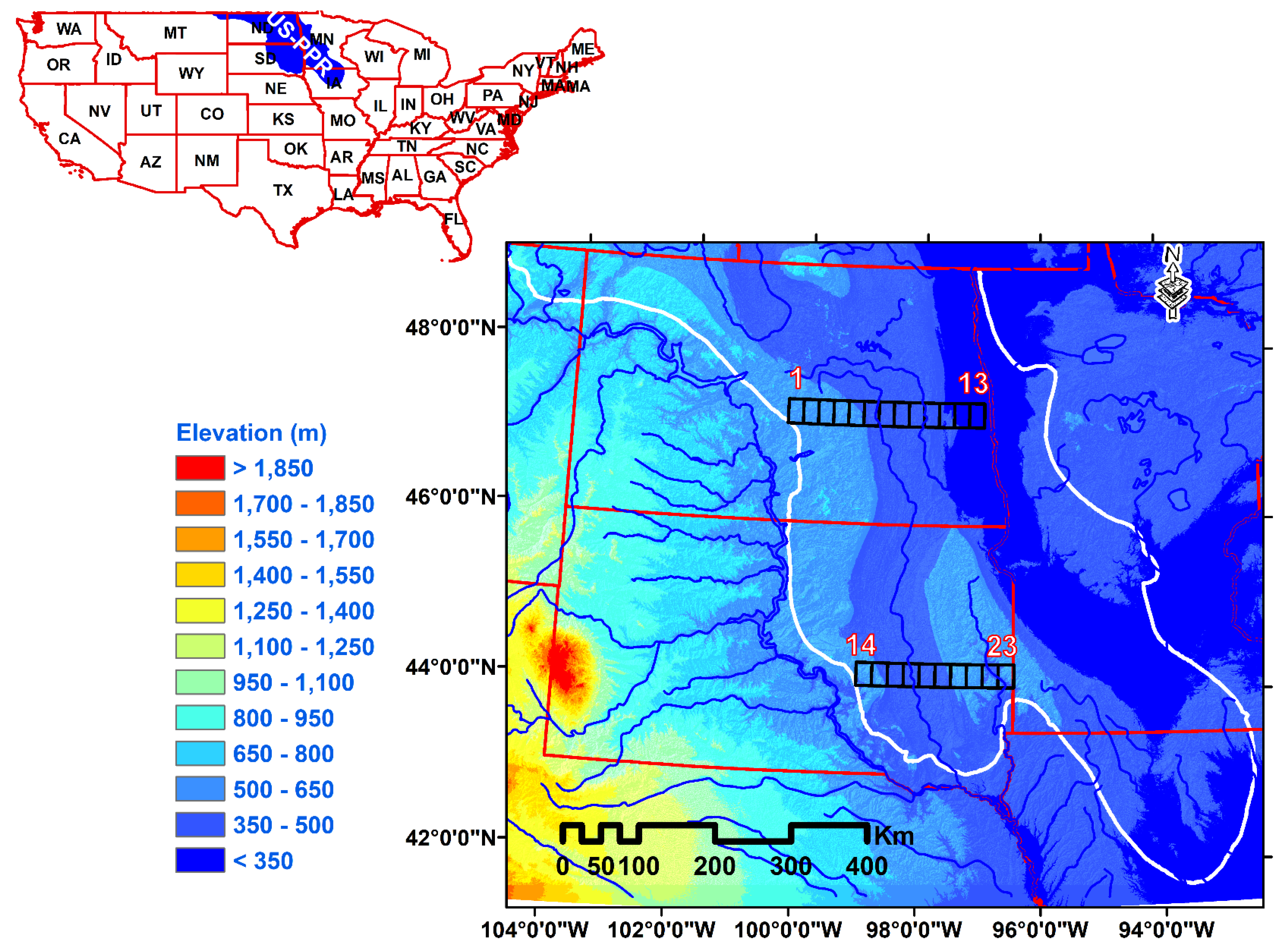
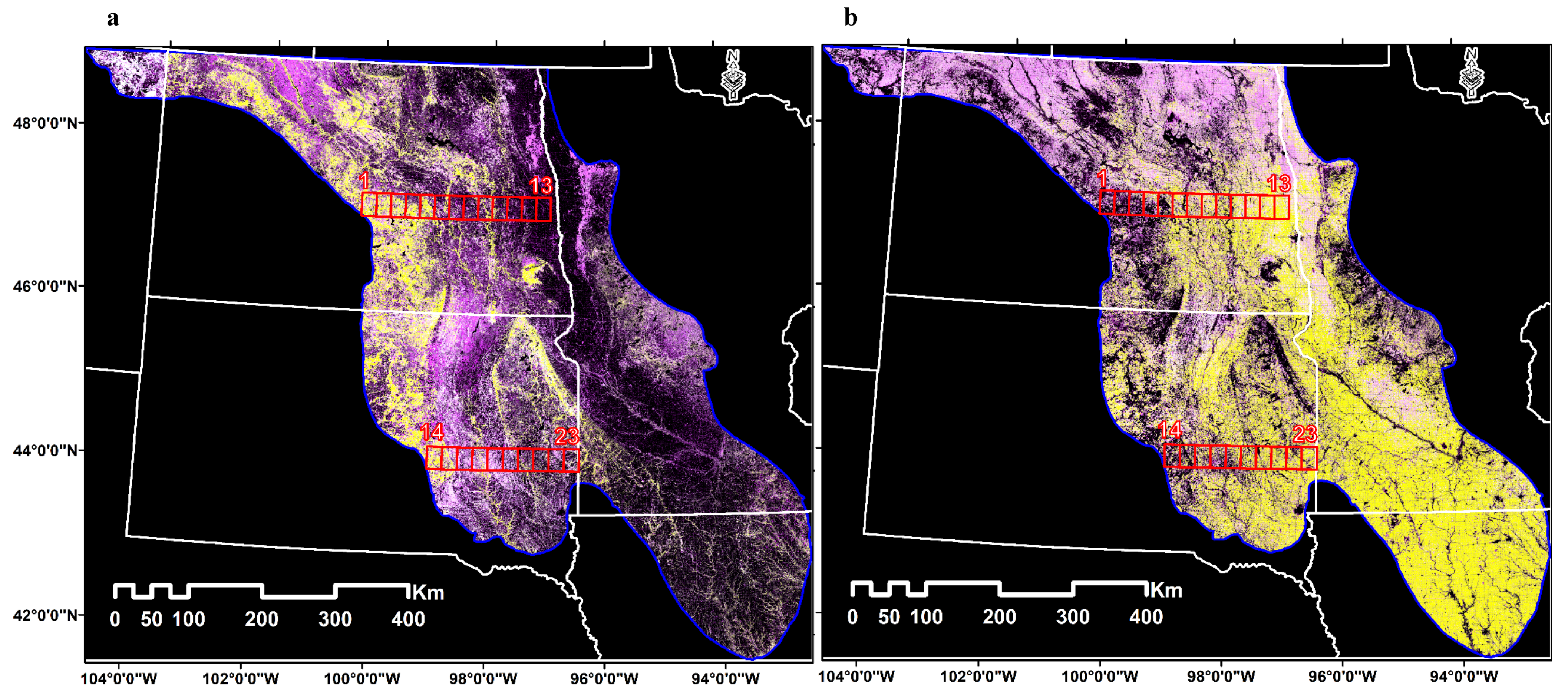
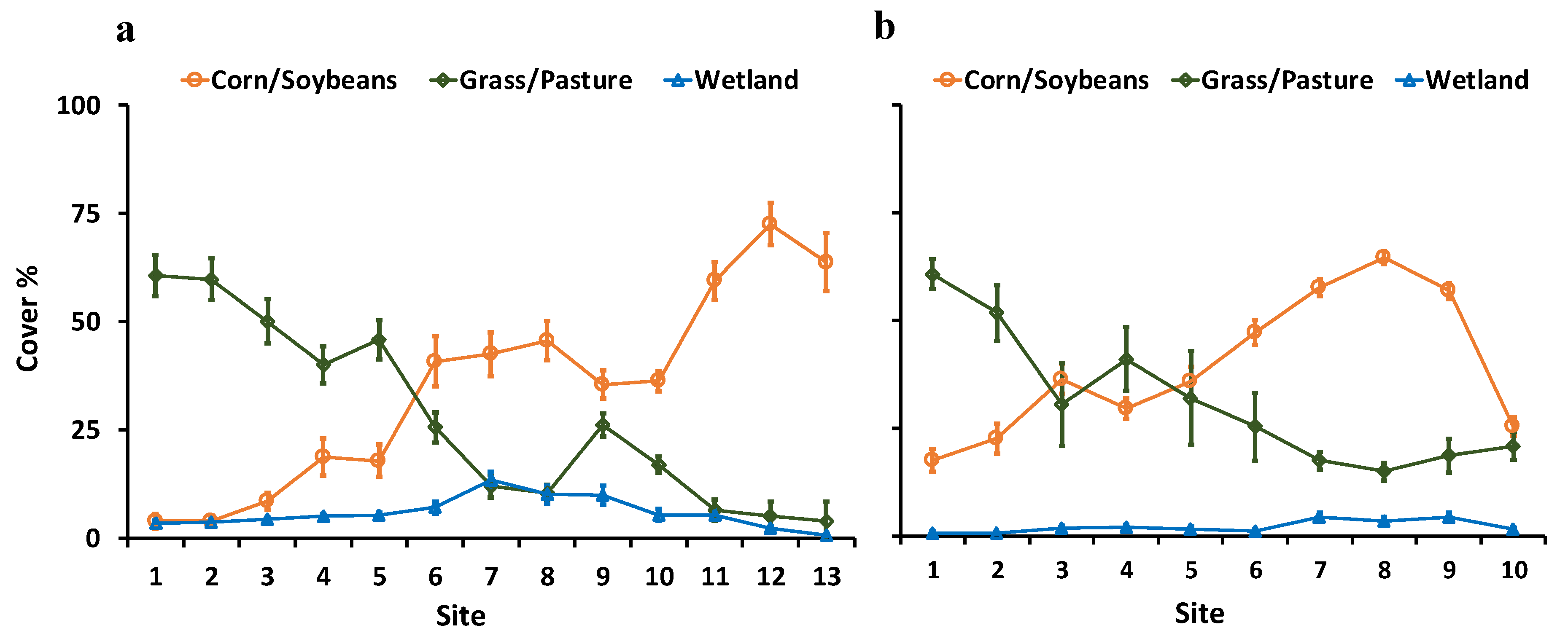
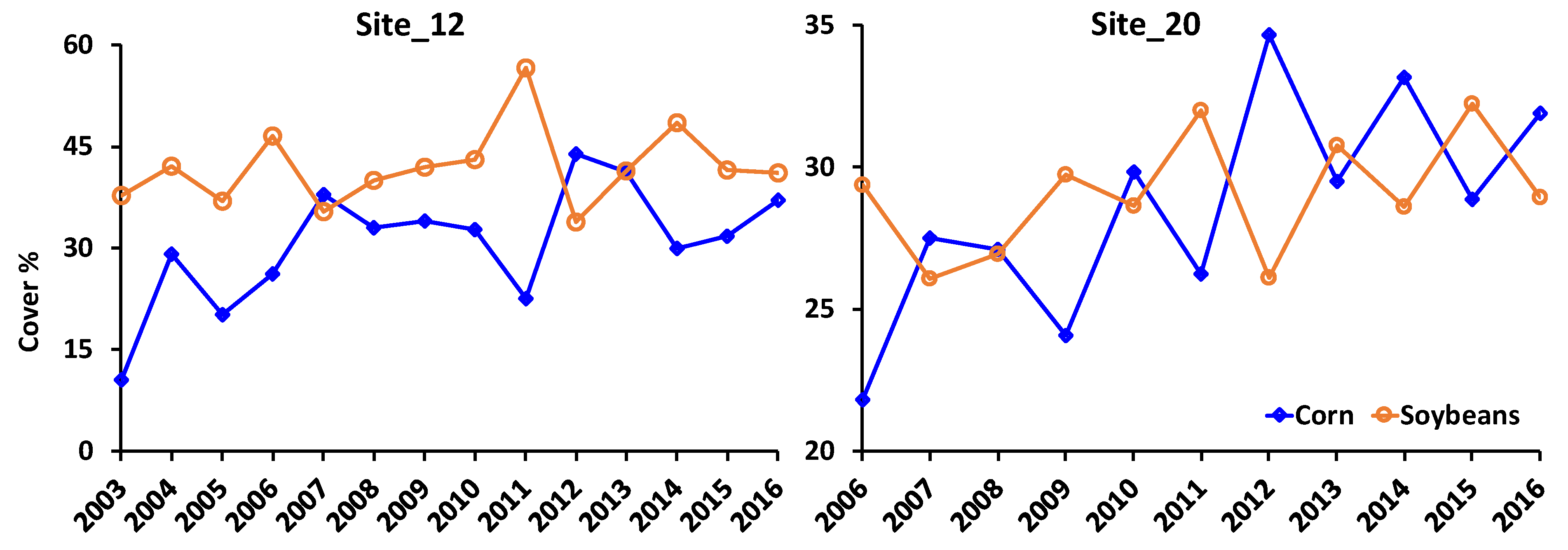
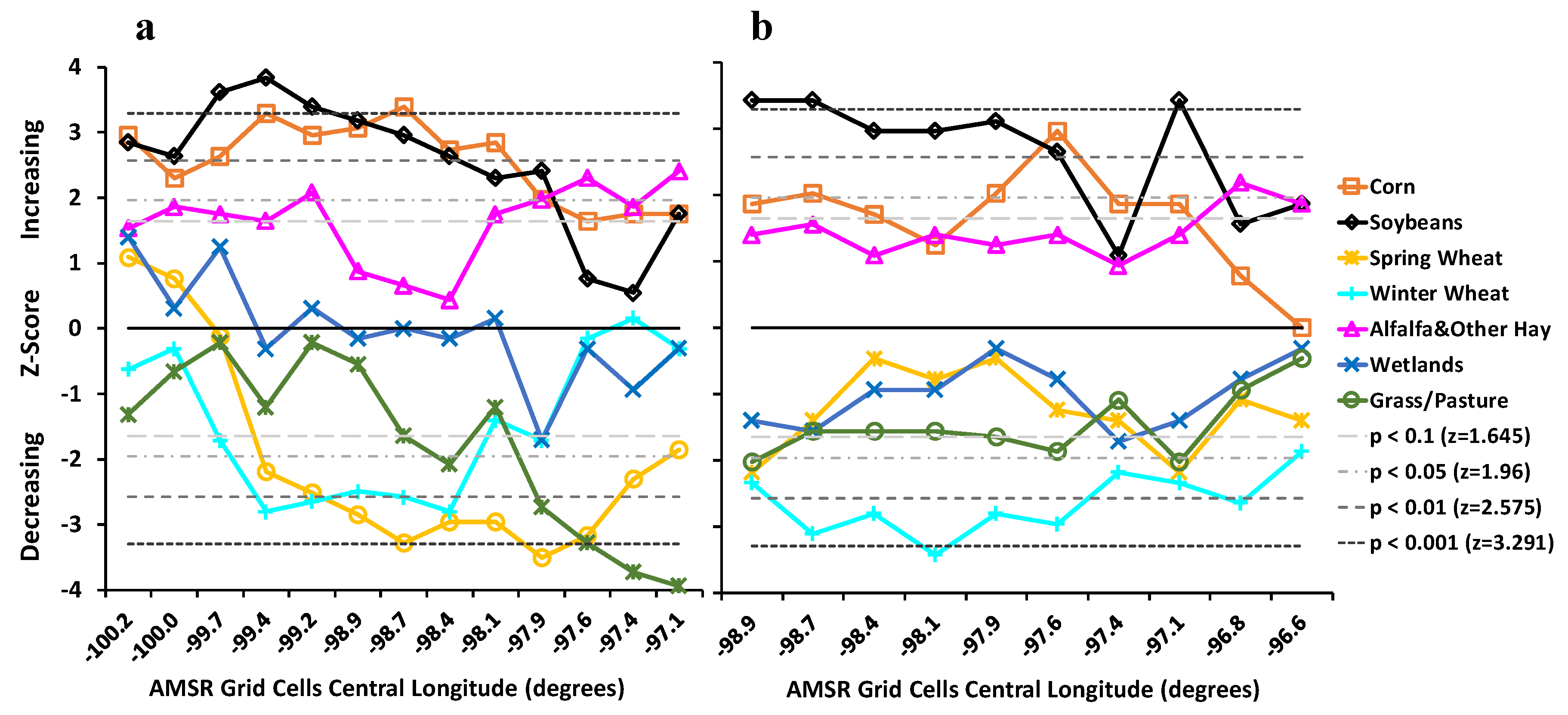


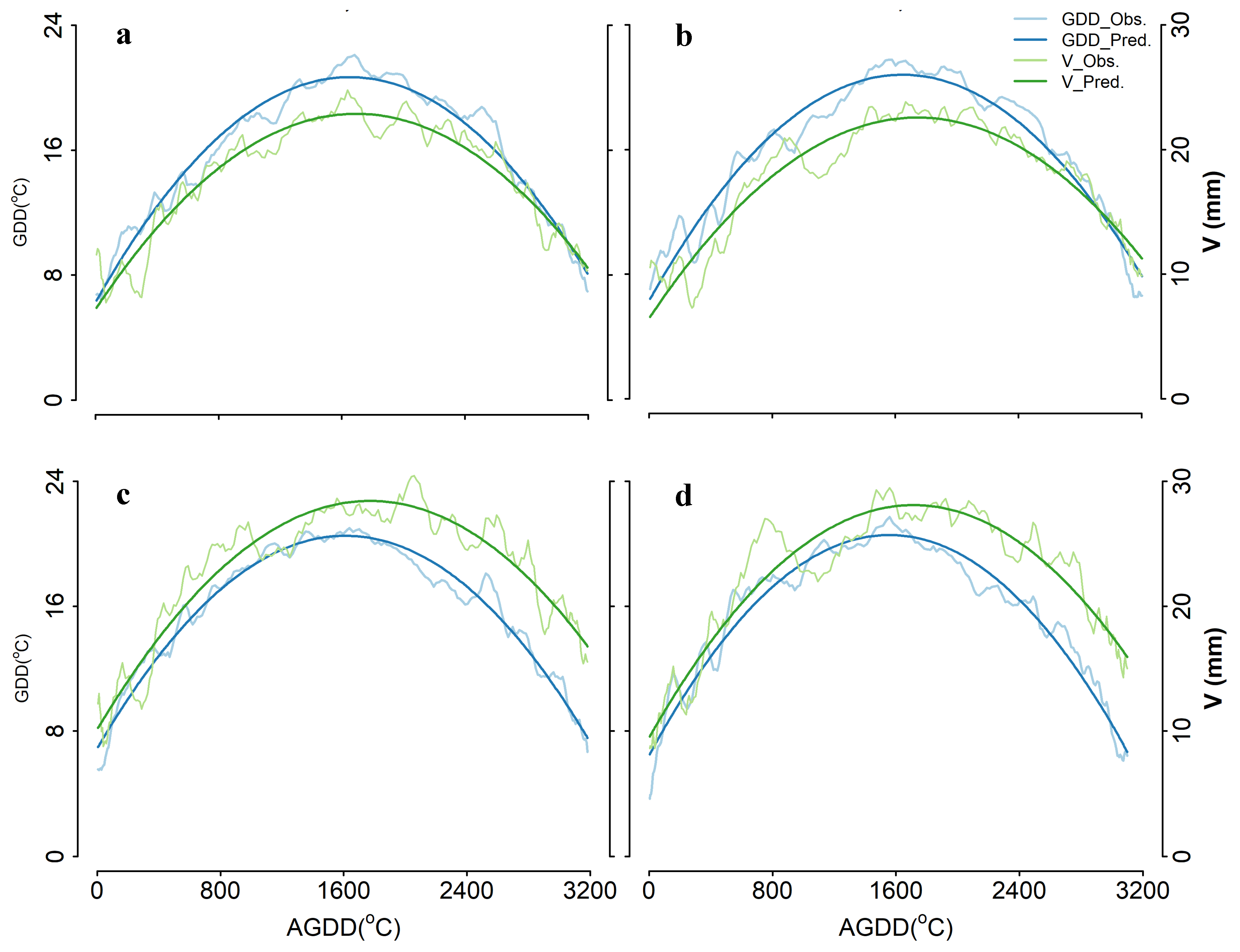
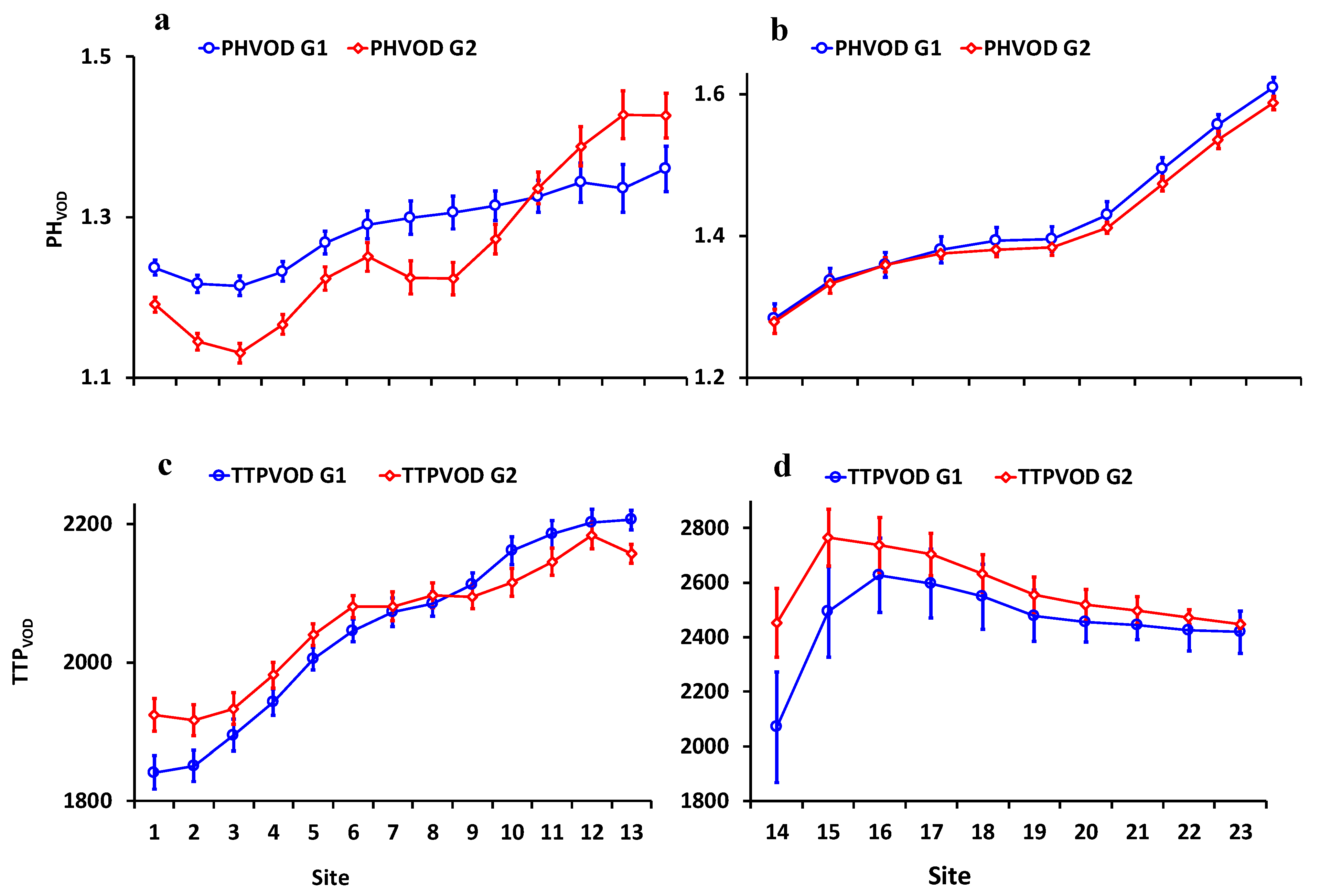
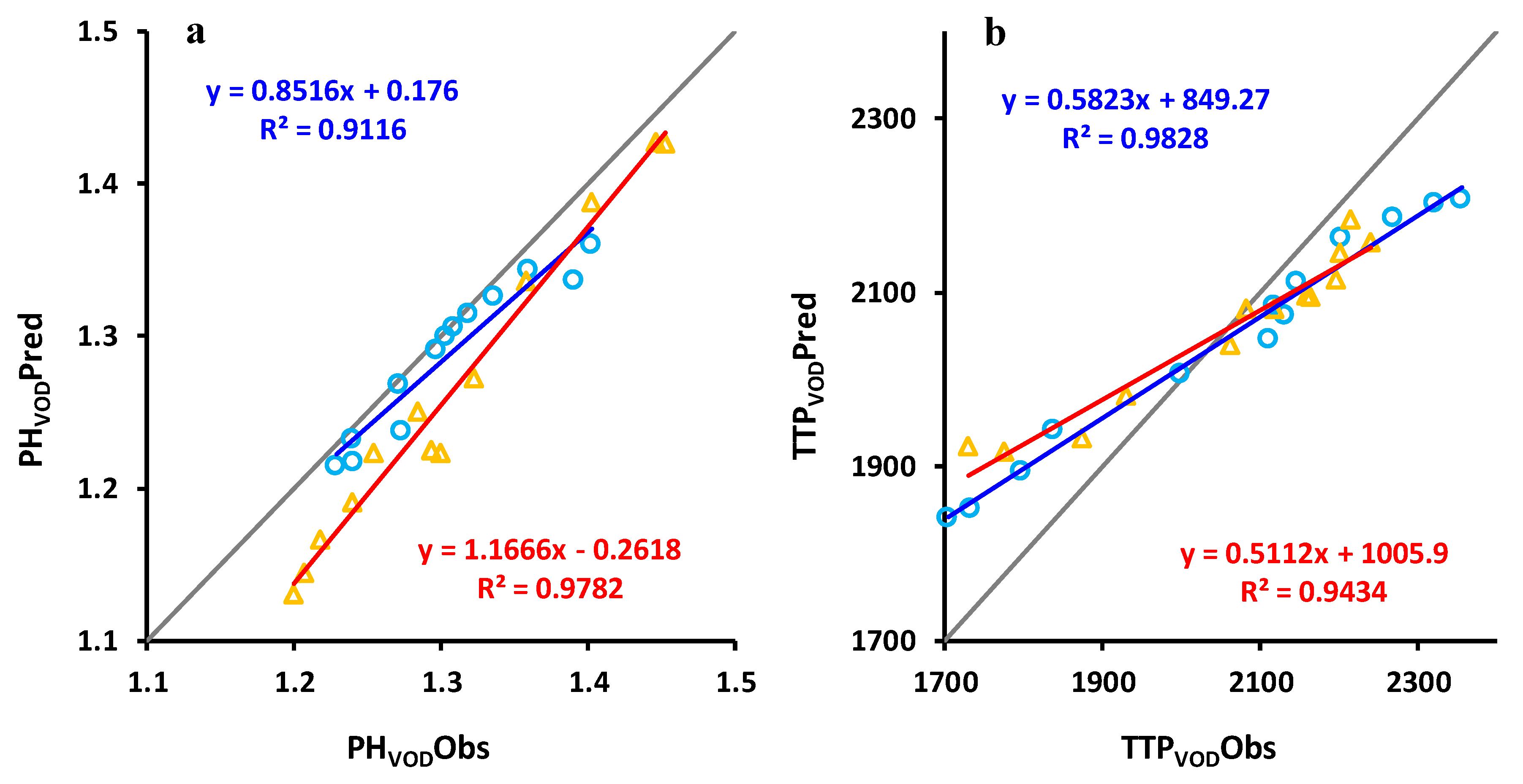
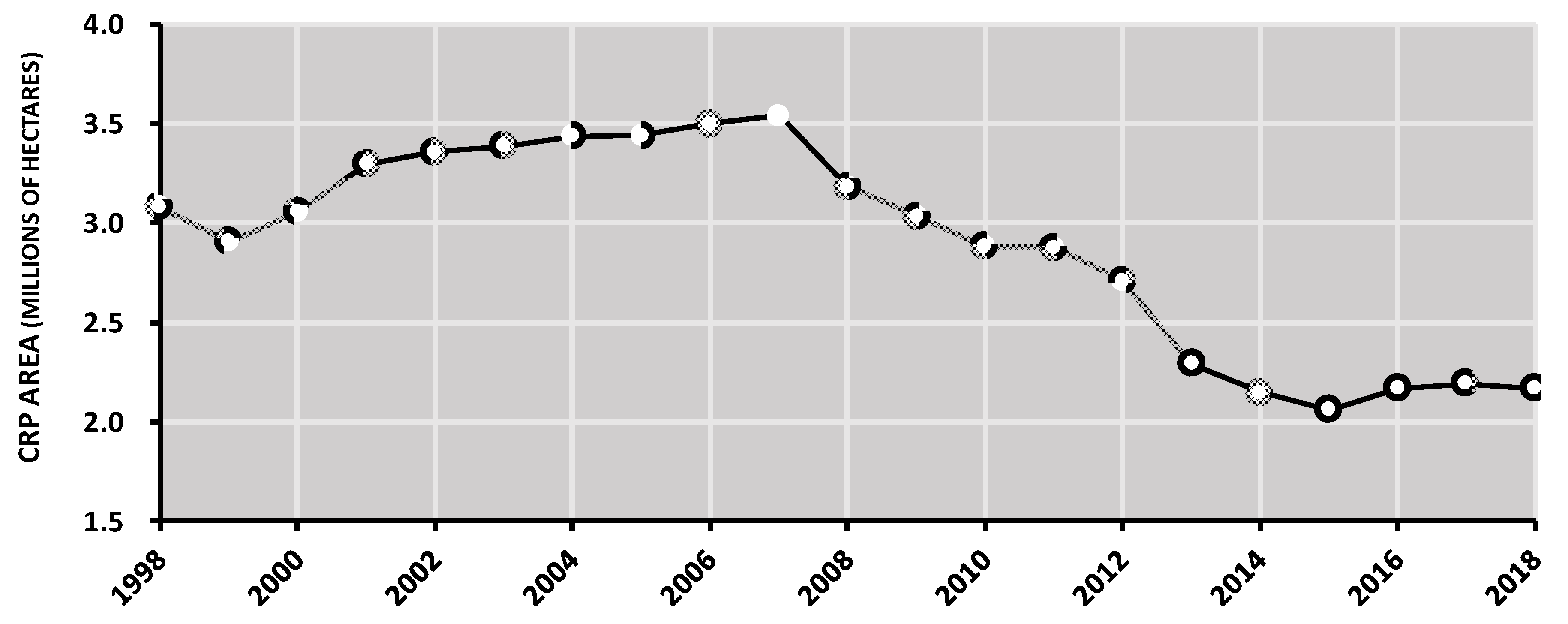
| site | Cover Type (%) | |||||||||
|---|---|---|---|---|---|---|---|---|---|---|
| Grass/Pasture | Corn | Soybean | Sunflower | Durum Wheat | Spring Wheat | Winter Wheat | Alfalfa | Other Hay | Wetlands | |
| North Dakota Sites | ||||||||||
| 1 | 60.7 | 1.0 | 2.8 | 0.8 | 0.1 | 7.6 | 0.1 | 0.9 | 2.5 | 2.7 |
| 2 | 59.8 | 1.0 | 2.9 | 0.5 | 0.1 | 5.6 | 0.1 | 1.2 | 4.7 | 2.8 |
| 3 | 50.1 | 1.9 | 6.6 | 0.6 | 0.1 | 7.9 | 0.2 | 1.1 | 2.3 | 3.4 |
| 4 | 40.0 | 4.3 | 14.5 | 1.1 | 0.2 | 12.2 | 0.2 | 0.8 | 1.5 | 4.0 |
| 5 | 45.8 | 4.0 | 13.9 | 0.8 | 0.1 | 8.1 | 0.3 | 1.0 | 1.8 | 4.1 |
| 6 | 25.6 | 12.2 | 28.7 | 1.3 | 0.0 | 9.0 | 0.1 | 1.0 | 1.0 | 5.6 |
| 7 | 12.0 | 9.8 | 32.7 | 0.9 | 0.0 | 14.4 | 0.1 | 0.6 | 0.5 | 10.5 |
| 8 | 10.3 | 11.9 | 33.7 | 1.1 | 0.0 | 19.1 | 0.1 | 0.4 | 0.3 | 7.9 |
| 9 | 26.2 | 9.1 | 26.4 | 0.3 | 0.0 | 15.2 | 0.2 | 1.1 | 0.5 | 7.8 |
| 10 | 16.9 | 16.3 | 35.7 | 0.6 | 0.0 | 11.2 | 0.2 | 1.0 | 0.4 | 4.2 |
| 11 | 6.4 | 22.0 | 37.4 | 1.2 | 0.0 | 14.2 | 0.2 | 0.7 | 0.1 | 4.2 |
| 12 | 5.1 | 30.7 | 41.9 | 0.7 | 0.0 | 8.1 | 0.2 | 0.3 | 0.1 | 1.7 |
| 13 | 3.9 | 17.2 | 46.6 | 0.7 | 0.0 | 18.4 | 0.1 | 0.2 | 0.1 | 0.4 |
| South Dakota Sites | ||||||||||
| 14 | 60.8 | 11.2 | 6.4 | 1.5 | 0.0 | 2.8 | 2.6 | 1.7 | 6.2 | 0.7 |
| 15 | 51.8 | 13.2 | 9.4 | 0.4 | 0.0 | 1.5 | 3.0 | 1.7 | 12.1 | 0.6 |
| 16 | 30.5 | 20.1 | 16.3 | 0.1 | 0.0 | 0.7 | 4.0 | 2.3 | 16.5 | 1.9 |
| 17 | 41.0 | 17.1 | 12.6 | 0.0 | 0.0 | 0.4 | 1.2 | 4.1 | 13.9 | 2.0 |
| 18 | 32.0 | 17.9 | 17.8 | 0.1 | 0.0 | 1.6 | 3.5 | 2.3 | 17.6 | 1.6 |
| 19 | 25.4 | 23.0 | 24.2 | 0.1 | 0.0 | 1.3 | 2.9 | 2.1 | 12.8 | 1.1 |
| 20 | 17.5 | 28.6 | 29.0 | 0.0 | 0.0 | 0.4 | 0.7 | 1.9 | 1.9 | 4.5 |
| 21 | 15.0 | 33.4 | 31.2 | 0.0 | 0.0 | 0.4 | 0.2 | 2.0 | 1.2 | 3.5 |
| 22 | 18.7 | 31.5 | 25.4 | 0.0 | 0.0 | 0.7 | 0.3 | 2.2 | 5.4 | 4.4 |
| 23 | 20.9 | 37.7 | 25.4 | 0.0 | 0.0 | 0.9 | 0.2 | 2.9 | 3.2 | 1.5 |
| Transect | stat | PHVOD | TTPVOD | PHGDD | TTPGDD | PHV | TTPV |
|---|---|---|---|---|---|---|---|
| ND | µd | −0.03 | 11.19 | 0.15 | −23.96 | −0.39 | 4.80 |
| p-value | 0.14 | 0.36 | <0.01 | <0.01 | <0.01 | 0.632 | |
| SD | µd | −0.01 | 122.38 | −0.06 | −51.68 | −0.458 | −53.23 |
| p-value | <0.01 | <0.01 | <0.01 | <0.01 | <0.01 | <0.01 |
© 2019 by the authors. Licensee MDPI, Basel, Switzerland. This article is an open access article distributed under the terms and conditions of the Creative Commons Attribution (CC BY) license (http://creativecommons.org/licenses/by/4.0/).
Share and Cite
Alemu, W.G.; Henebry, G.M.; Melesse, A.M. Land Surface Phenologies and Seasonalities in the US Prairie Pothole Region Coupling AMSR Passive Microwave Data with the USDA Cropland Data Layer. Remote Sens. 2019, 11, 2550. https://doi.org/10.3390/rs11212550
Alemu WG, Henebry GM, Melesse AM. Land Surface Phenologies and Seasonalities in the US Prairie Pothole Region Coupling AMSR Passive Microwave Data with the USDA Cropland Data Layer. Remote Sensing. 2019; 11(21):2550. https://doi.org/10.3390/rs11212550
Chicago/Turabian StyleAlemu, Woubet G., Geoffrey M. Henebry, and Assefa M. Melesse. 2019. "Land Surface Phenologies and Seasonalities in the US Prairie Pothole Region Coupling AMSR Passive Microwave Data with the USDA Cropland Data Layer" Remote Sensing 11, no. 21: 2550. https://doi.org/10.3390/rs11212550








